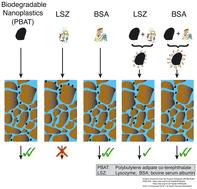当前位置:
X-MOL 学术
›
Environ. Sci.: Nano
›
论文详情
Our official English website, www.x-mol.net, welcomes your feedback! (Note: you will need to create a separate account there.)
Mobility of soil-biodegradable nanoplastics in unsaturated porous media affected by protein-corona
Environmental Science: Nano ( IF 5.8 ) Pub Date : 2024-06-21 , DOI: 10.1039/d4en00140k Yingxue Yu 1 , Odeta Qafoku 2 , Libor Kovarik 2 , Anton F. Astner 3 , Douglas G. Hayes 3 , Markus Flury 4, 5
Environmental Science: Nano ( IF 5.8 ) Pub Date : 2024-06-21 , DOI: 10.1039/d4en00140k Yingxue Yu 1 , Odeta Qafoku 2 , Libor Kovarik 2 , Anton F. Astner 3 , Douglas G. Hayes 3 , Markus Flury 4, 5
Affiliation

|
Soil-biodegradable plastic has been increasingly used as mulches in agriculture, which provides not only agronomical benefits but also in situ disposal and biodegradation options. However, soil-biodegradable plastic mulches inevitably fragment into micro- and nanoplastics during biodegradation, which can reside in soils or migrate into deep soils, where they may not degrade readily due to reduced microbial activity. To date, little is known about the transport of soil-biodegradable micro- and nanoplastics in soils. Here, we studied the transport of soil-biodegradable nanoplastics (∼200 nm) made of polybutylene adipate co-terephthalate (PBAT) in unsaturated sand (proxy for soil). Specifically, we studied the mobility of pristine and weathered PBAT nanoplastics in the absence and presence of proteins (positively charged lysozyme and negatively charged bovine serum albumin, pH = 7.7). We found that (1) both pristine and the weathered PBAT nanoplastics were mobile; (2) positively charged lysozyme formed protein-coronas around PBAT nanoplastics and inhibited the transport; and (3) decreased water saturation promoted the retention of PBAT nanoplastics via physical straining. These results suggest that soil-biodegradable nanoplastics fragmented from soil-biodegradable plastic mulches are mobile and may readily migrate into deep soil layers, but positively charged proteins and unsaturated flow would prevent such transport via formation of protein-corona and physical straining.
中文翻译:

蛋白质电晕影响的不饱和多孔介质中土壤可生物降解纳米塑料的迁移性
土壤可生物降解塑料越来越多地用作农业覆盖物,这不仅提供了农艺效益,还提供了就地处置和生物降解选项。然而,土壤可生物降解的塑料覆盖物在生物降解过程中不可避免地会碎裂成微米和纳米塑料,这些塑料可以驻留在土壤中或迁移到深层土壤中,由于微生物活性降低,它们可能不易降解。迄今为止,人们对可生物降解的微塑料和纳米塑料在土壤中的迁移知之甚少。在这里,我们研究了由聚己二酸-对苯二甲酸丁二醇酯(PBAT)制成的土壤可生物降解纳米塑料(∼200 nm)在不饱和沙(代表土壤)中的传输。具体来说,我们研究了原始和风化的 PBAT 纳米塑料在蛋白质(带正电的溶菌酶和带负电的牛血清白蛋白,pH = 7.7)不存在和存在的情况下的流动性。我们发现(1)原始和风化的 PBAT 纳米塑料都是可移动的; (2)带正电荷的溶菌酶在PBAT纳米塑料周围形成蛋白冠并抑制其运输; (3) 水饱和度的降低通过物理应变促进了 PBAT 纳米塑料的保留。这些结果表明,从土壤可生物降解塑料覆盖物中分离出来的土壤可生物降解纳米塑料是可移动的,并且可能很容易迁移到深层土壤中,但带正电荷的蛋白质和不饱和流动将通过形成蛋白质电晕和物理应变来阻止这种运输。
更新日期:2024-06-21
中文翻译:

蛋白质电晕影响的不饱和多孔介质中土壤可生物降解纳米塑料的迁移性
土壤可生物降解塑料越来越多地用作农业覆盖物,这不仅提供了农艺效益,还提供了就地处置和生物降解选项。然而,土壤可生物降解的塑料覆盖物在生物降解过程中不可避免地会碎裂成微米和纳米塑料,这些塑料可以驻留在土壤中或迁移到深层土壤中,由于微生物活性降低,它们可能不易降解。迄今为止,人们对可生物降解的微塑料和纳米塑料在土壤中的迁移知之甚少。在这里,我们研究了由聚己二酸-对苯二甲酸丁二醇酯(PBAT)制成的土壤可生物降解纳米塑料(∼200 nm)在不饱和沙(代表土壤)中的传输。具体来说,我们研究了原始和风化的 PBAT 纳米塑料在蛋白质(带正电的溶菌酶和带负电的牛血清白蛋白,pH = 7.7)不存在和存在的情况下的流动性。我们发现(1)原始和风化的 PBAT 纳米塑料都是可移动的; (2)带正电荷的溶菌酶在PBAT纳米塑料周围形成蛋白冠并抑制其运输; (3) 水饱和度的降低通过物理应变促进了 PBAT 纳米塑料的保留。这些结果表明,从土壤可生物降解塑料覆盖物中分离出来的土壤可生物降解纳米塑料是可移动的,并且可能很容易迁移到深层土壤中,但带正电荷的蛋白质和不饱和流动将通过形成蛋白质电晕和物理应变来阻止这种运输。











































 京公网安备 11010802027423号
京公网安备 11010802027423号